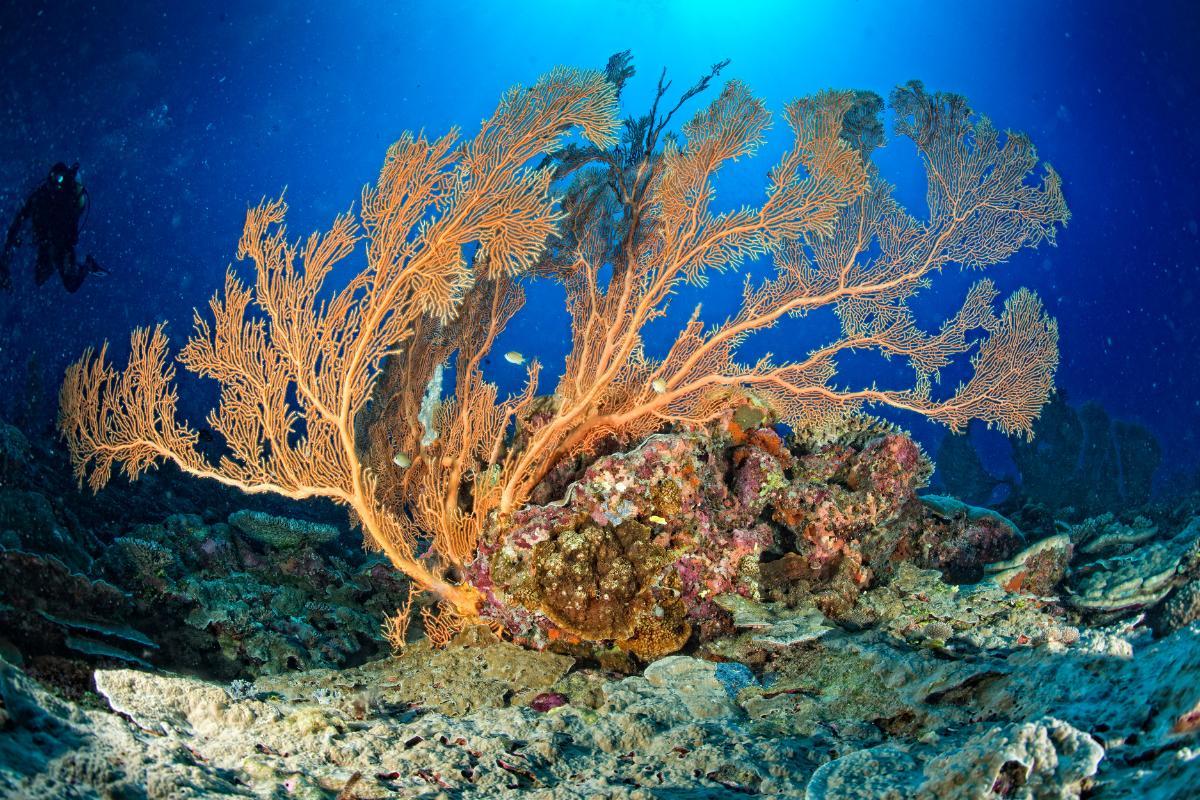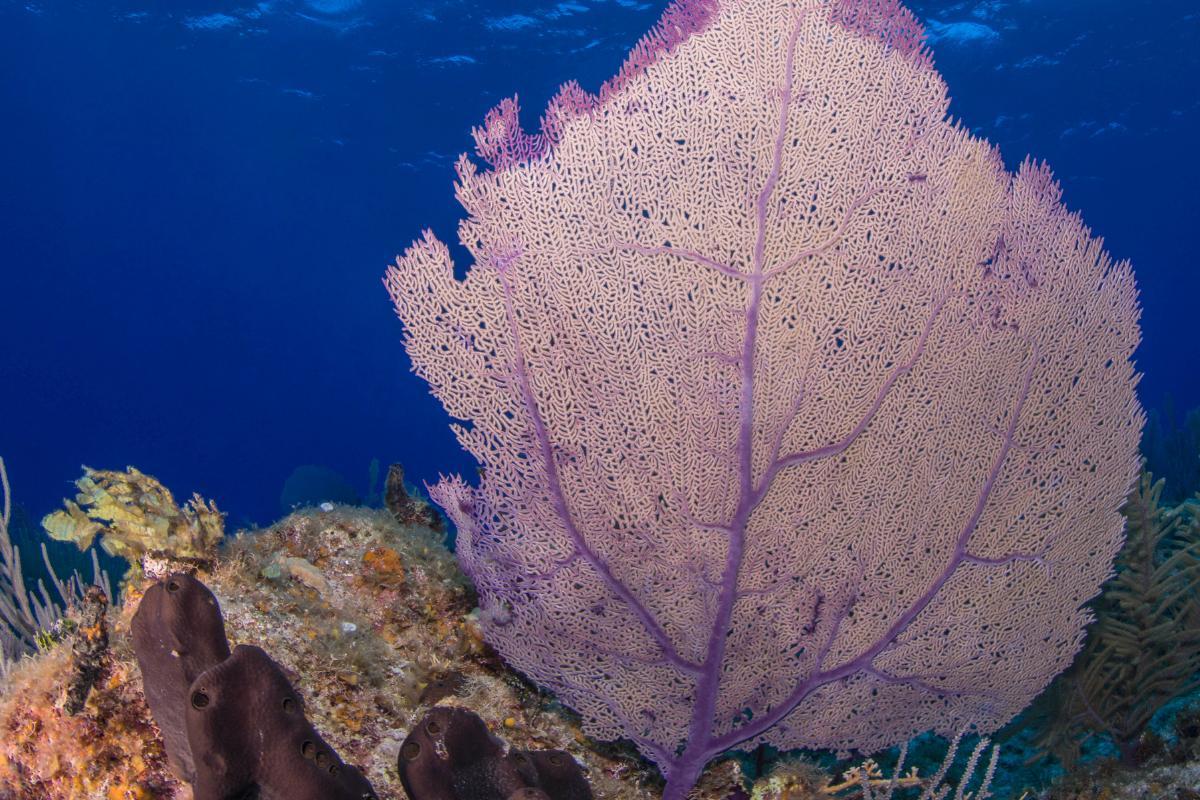Gorgonian Coral - Characteristics, Habitat and Diet


The gorgonian coral is a type of soft marine coral that belongs to the family Gorgoniidae. There are various genera within this group, all of which are types of Cnidarian, members of the phylum which also includes jellyfish, sea anemones and other marine species. Despite being part of the same taxonomic phylum, these animals differ in various striking ways. For gorgonian corals, the structure is composed of polyps which have eight pinnate tentacles (meaning they have side branches resembling a feather). The central axis of the gorgonian coral is surrounded by calcareous hardened body parts known as sclerites.
At thedailyECO, we explain how these characteristics of gorgonian corals allow them to survive in often harsh marine environments. Specifically, we find out how they allow them to feed, reproduce and carry out the various behaviors indicative of their species.
What are gorgonian corals?
Gorgonians are octocorals, meaning they are part of the class Octocorallia (aka Alcyonacea), itself part of the subphylum Anthozoa. These colonial organisms which are formed by polyps, one of the two forms of which cnidarians can present. The other is a medusa, something seen in the adult stages of jellyfish and other species. As with all anthozoans, gorgonian corals never have a medusa stage. Instead, the polyps colonize on a stalk which gives their form.
These colonial octocorals are part of the order Alcyonacea. Of the six suborders, gorgonian corals can be found in three. Specifically, they are Calcaxonia, Holaxonia and Scleraxonia. Members of this order are sometimes known as sea fans or sea whips. This is due to the shape which the polyp colonies make to form the one gorgonian coral organism.
Some of the main characteristics of gorgonian corals are:
- They are abundant and characteristic components of shallow waters in which they settle on rocky structures, coral reefs and soft sediments.
- Their structure is composed of polyps with eight pinnate tentacles, i.e. tentacles with feather-like lateral branches. These polyps emerge from a tissue called cenenchyme, which contains sclerites. Despite being considered a type of soft coral, these are microscopic structures of calcareous origin that provide hardness and support to the colony.
- They have a central scleroproteic axis made up of gorgonin, a complex protein similar to keratin. Gorgonin can have different degrees of internal mineralization. These are similar to the calcium carbonate aragonite crystals used by hard corals (scleractinians) to form their colonies. This hardened central axis is surrounded by the coenenchyme layer where the sclerites and polyps are found.
- They present different growth forms ranging from encrusted colonies to erect tree-like forms or huge fans.
- They host a large number of organisms such as marine sponges, mollusks, polychaetes, crustaceans and fish. They form strong symbiotic associations with some of these marine animal species. They present various colors such as yellow, orange and lavender. This color is derived from the calcareous skeletal components or even from some of their symbionts. Learn more with our article on what is symbiosis in biology?
- They are long-lived, having very few natural predators and showing no seasonality.
- They reach their maximum size between 10 and 30 years of age.
- They are considered as bioindicators of environmental quality, meaning they can help to understand how well an overall ecosystem is functioning.
- They are also considered ecosystem engineers because of their long life expectancy. It is also due to their three-dimensional structure by which they can modify the environment, facilitating the settlement of other species and generating breeding areas for many associated organisms of ecological and economic interest.
- They can concentrate in dense groups constituting submarine forests, areas with particularly high biodiversity. Our article on kelp forest characteristics helps us to better understand another type of underwater organism which lives in dense groups.
Learn more about other types of cnidarian with our article on the different types of jellyfish species.

Where do gorgonian corals live?
In terms of gorgonian habitat, these soft corals are distributed throughout all the seas and oceans of the world. They are attached to hard substrates such as rocks or dead coral reefs and are located in areas with moderate marine currents. They can be found at different depths, with some species inhabiting shallow water and others reaching several hundred meters deep.
There are some common species in the Mediterranean Sea. They include the violescent sea-whip (Paramuricea clavata), a fan-shaped colonial gorgonian which is usually found on rocky or coralligenous bottoms usually located between 15 and 40 meters deep. There are records in which it has been found at more than 100 meters. Other species such as the common sea fan (Gorgonia ventalina) can be found in the western Atlantic Ocean and Caribbean Sea. It grows in shallow water near the coast where the waves are strong.

Gorgonian coral diet
Gorgonians have a form of passive feeding. This is because their organism grows perpendicular to the sea currents, taking advantage of the tentacles of their polyps to capture planktonic organisms and organic particles which pass by in the water. Those organisms that harbor single-celled zooxanthellae benefit from the sugars produced by these symbiotic dinoflagellates.
How do gorgonian corals reproduce?
Gorgonian corals reproduce in two main ways:
- Asexual reproduction: they have the ability to regenerate and branch their tissues. This means that they can develop new branches from their existing structure. These new shoots grow and separate from the parent colony, forming new colonies which are genetically identical.
- Sexual reproduction: some species have separate sexes and others are hermaphrodites. Whatever the case, they produce gametes in the form of eggs and sperm. The release of gametes into water generally occurs during synchronized reproductive events, such as seasonal changes or specific chemical signals in the environment. When eggs are fertilized by sperm, planktonic larvae called planula larvae develop. These larvae are swept away by ocean currents and eventually settle on the appropriate substrate. They then begin to develop into polyps and form a new colony.
In our related article, you can learn more about asexual reproduction in plants and animals.

Threats and conservation of gorgonian corals
Almost all gorgonian coral species have a slow growth rate and late sexual maturation. These factors combine to make them highly vulnerable to current and future types of environmental impact. Among the most important threats faced by gorgonian corals are:
- Increased water temperature due to climate change
- Fishing activities
- Invasive species such as brown macroalgae (Rugulopteryx okamurae)
- Pollution
- Irresponsible diving for sport
We must be aware that the disappearance of these engineered species not only leads to negative consequences for the species itself. It can indirectly affect the entire aquatic community by modifying habitat conditions and decreasing the availability of resources. They are considered essential for the biodiversity of marine communities[1]. For these reasons, the conservation efforts to protect these environments are increasing. These include:
- Creation of protected areas
- Active restoration processes to recover the structure and functioning of these ecosystems
- Control and eradication of invading organisms
- Awareness campaigns to make the problems visible and show the importance of conservation
- Regular monitoring of gorgonian populations and scientific research into effective conservation strategies
- Projects associated with climate change mitigation can help the long-term survival of gorgonian corals and other marine ecosystems
Now that you know the characteristics of gorgonian corals, including their habitat and diet, you can see the importance of conserving their colonies. Learn more about marine conservation with our article on the definition and principles of the blue economy.
If you want to read similar articles to Gorgonian Coral - Characteristics, Habitat and Diet, we recommend you visit our Biodiversity category.
1. L. Iborra, M. Leduc, L. Fullgrabe, P. Cuny, & S. Gobert. (2022). Temporal trends of two iconic Mediterranean gorgonians (Paramuricea clavata and Eunicella cavolini) in the climate change context. Journal of Sea Research, 186, 102241.
https://doi.org/10.1016/j.seares.2022.102241
- Breedy, O., & Cortés, J. (2014). Gorgonias (Octocorallia: Gorgoniidae) from the shallow waters of the North Pacific of Costa Rica.
- Montseny, M., Florido, M., Barranco, C. N., & López-González, P. J. (2022). Threatened gorgonian forests in the Strait Natural Park. Assessment of the state of conservation and implementation of restoration measures. GOTARES Project.








